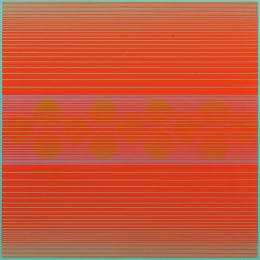“Listen – I’m a sculptor – I know nothing about printmaking …”
In the second in our series of interviews exploring collaborative relationships Katherine Oliver interviews sculptor Willard Boepple and printmaker Kip Gresham to find out what makes a successful printmaking partnership. Boepple has been travelling to The Print Studio, Cambridge to work with Gresham on his screenprints since 2003.
(KO to WB) Tell us about your first printmaking experience:
(WB) Well, not counting some stuff in college, working with Kip was my first. It was 2003 and my wife and I were living in London. She was working for the mayor of London at the time – Ken Livingstone. We thought she was going to be working there for six months and it ended up being four years. So, I had not planned to actually move my studio there, I had just decided that I would draw and do other things, because I thought we’d be returning home shortly. And then it became clear that it wasn’t going to be so shortly – which was great news because I loved being in London.
Since I started making sculpture, London in a way had been my sculptural home in that the sculptors I’d been most interested in when I was starting out were all British. I had taken myself over there in 1970 and called a bunch of them up and asked if they’d be willing to meet for a beer to talk about this and that, and they were most welcoming. They were a wonderful group that I’m still mostly in touch with (those who are still around of course). And then I had the good fortune of marrying a British woman!
So, I started just to look for things to do which meant that I didn’t have to set up a studio myself because I thought we were returning to the States at some point. The first thing I did was go and see Phil Stroud in Dorset to work on some versions of sculptures that I’d already made in wood – and we started to do some casting in translucent resin. The reason I mention this as a stand-out in my sculptural enterprise is that working in translucent resin was a big new step – it was a real discovery – to build a sculpture that I could see inside of. And then my friend Pete Griffin introduced me to Kip at an opening of my work at the Broadbent Gallery in Notting Hill. Kip said why don’t you come and see me, and we can do something together. I said listen – I’m a sculptor – I know nothing about printmaking. And he said – I love working with sculptors – they’re not afraid of materials. So off I went, and I brought with me some drawings of elements of the translucent sculptures – elements within the sculpture that were all stacked together.
I also took two or three actual sculptures with me which were fairly simple wall pieces, each comprised of something like four or five elements. They had a kind of mechanical look to them, as if they did something important like vacuum or grind. I took the shapes that the sculptures were composed of and that became the beginning of some prints. We took those shapes and put them on the silk-screen and made templates. And then we then put some colour through and built them up to see what happened. Working with those shapes in a given structure, I arranged them on the page, so they become their own thing. A matrix of shapes layered over one another with colour pulled into them was what built the prints. Working with resin and layering in printmaking fit together beautifully.

(KO) How do the prints relate to your other, more solid sculptures?
(WB) That is such a good question that often gets asked by me! There’s nothing conscious – I very rarely take a sculpture and use it as a basis for a print. However, that said, it’s inevitable. Here I am, sitting in the studio and I’ve got some drawing paper on the table and I start thinking about what I want to make the next print about. In this environment there are probably twenty or thirty sculptures around me right now. It’s inevitable that I’m seeing bits and pieces that come into play but, you know, it’s not by design that it happens.
The other thing that happens also, that is true of my work from the 60’s onwards, is I’ll see common threads that come through in wildly different media and forms and shapes. I’m in there looking for something in each of these sculptures. And often it’s surprising to me how consistent the search can be and at moments – wow! – I’m looking around the same thing – this gesture, or an embrace, a relationship. My sculptures are abstract, of course, but they’re all about the relations of parts. That is what brings it all together.
(KO) Do you ever look at one of your prints and it gives you an idea for a new piece of sculpture?
(WB) I can’t say ‘neat tightly yes’ but I can say that they influence each other. But it’s as though, again, I see my own handwriting there and then I find myself doing something that we did on the screen. I can’t think of a time when I made a deliberate move – ‘I want to do this’. I just know it happens!
I just got a big crate of prints that I made in February with Kip, up here to my studio in Vermont to show some artists and critics. We were leafing through this stack of prints and they’re saying – look at how sculptural these are. Although they started and they continue to be strongly related to the sculpture it’s not as if I’m going about the process of building a print based on a sculpture or vice versa. What the sculptural qualities give me, I would say, are a sense of drawing. The plan that we make – the template that we begin with, of four or five shapes – that will be like a ladder structure, an order, something that makes sense and then moves me somehow and fills the page in a certain way.
But then the real making of it and the finding of it happens when the colour comes in. These prints are built with colour. We work quite thinly. So, if you look at a typical print, let’s say there are three or four elements, and each of those elements probably gets a minimum of dozen thin layers of colour – it may look like just one whack (you might think – oh, they got it right!) but no, they’re very thin layers. We might start off with a yellow, a grey and a red, but they’ll be quite thin, and we’ll lighten and deepen them, and we can swing them this way and that and that’s how the prints get built.
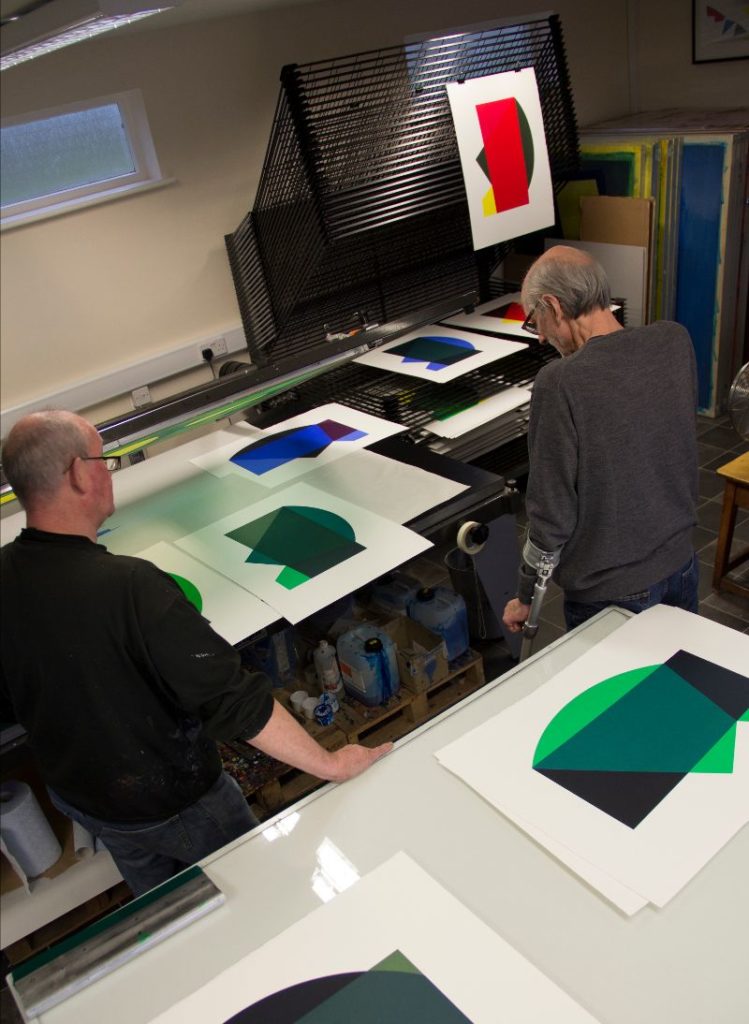
(KO) Why do you travel all the way to Cambridge to make prints with Kip?
(WB) Why is Kip so important to me? In the first place he’s just a dream to work with – he’s both open and participatory and very willing to offer an opinion, say – you know, I think you should go this way or that – without getting a big ego involved and being miffed if I don’t! It’s a real working relationship that is beautiful and rare. It’s been while, since 2003. We’ve just got to know each other quite well and so the work methods are very – I won’t say ingrained – but we just know each other, it’s very instinctive. What I’ve neglected to mention so far is what a master craftsman he is – my Lord! When I show my work here to professional printmakers in the US and they ask – why don’t you ever make prints here? – and I say – why don’t you take a look at my prints – and they say – oh – I see. They see the rigour with which Kip works. It’s all about registration. Things stay where they’re meant to stay. The structure that we start with has a very firm foundation, there’s no escape from what I did there, there’s no wobble. And whenever we have accidents that of course are such a crucial part of making art, for Kip it’s often despair – but for me, it’s joy.
(KO) Choose one print from the Printed Editions website that you love and tell us why:
(WB) I love this print by Mali Morris for its sense of serious, playful search:
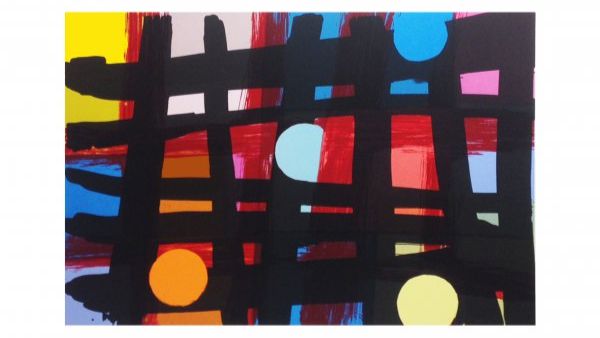
(KO to KG) Tell us about how you collaborate with artists in the studio, particularly those who you haven’t worked with before:
(WB) Collaboration in printmaking is always different; it depends on an artist’s thinking and their objectives. Sometimes, the artist is used to working with others, happy to accept that assistants might have particular skills that they as the artist don’t have the time to acquire (sculptors are a prime example). In other instances, artists like working alone and are insistent that every element in the piece emerges from their own hand. All artists are pre-conditioned, they all have their ‘givens’, their rules, their patterns of behaviour that they bring to the party. These interests, beliefs, attitudes, rituals or tics are manifested in many ways; the format or scale that they are comfortable with, the kind of palette that they use, the tools that they find easy to handle, and the way they approach a new piece of work.
My role as a collaborator requires me to recognise these characteristics and to set aside any concept of routine. There can be no house style or norm. Each relationship is new and demands its own structure. Sometimes we start with colour alone – no image – just the search for an evocative colour with its own echoes and resonances. Other times, we might start with a structure – geometric, fluid or adaptable. Whichever way we enter the story, it always boils down to the same thing – it has to work on its own terms.
The big imponderable is the image. An artist might bring along a pile of of un-assembled collage, some unrelated drawings, or a group of shapes that have to talk to one another. I never know what’s coming! Ideally the whole of the artwork is made here in the studio using materials and tools that are designed for printing but often the artists bring elements from their own studios hoping either to incorporate them directly into the work or to use them as guides or templates.
Printmaking works in layers. Whilst these layers are discrete elements and separate thoughts, they can overlay earlier statements and fuse together, sit beside each other or obliterate one another completely. Together, they become new thoughts – and this is where the excitement happens. Of course, an ‘Original Print’ can be monochromatic, but it is in the layering and its life on the substrate that a totally new language is written.
My job is to intuit, advise, provide materials, help to create the printing matrices and guide the artist through the proofing process. The running of the edition, if there is one, is the easy bit.
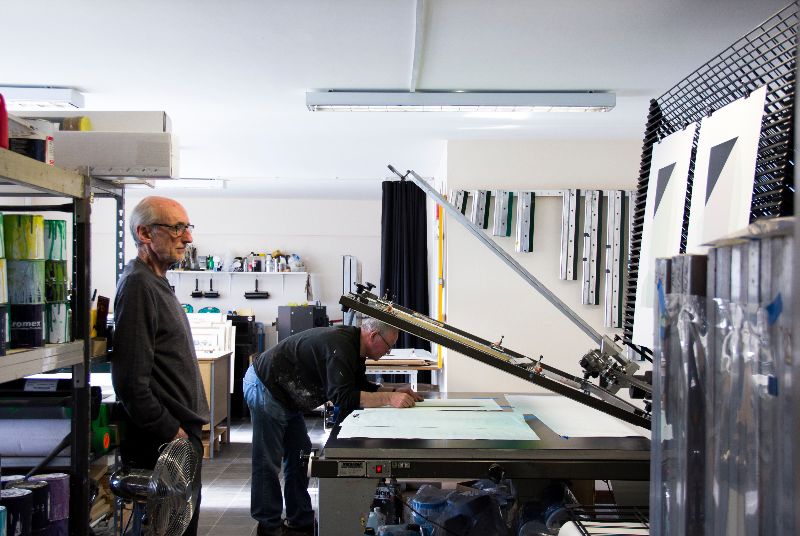
(KO) How can the process of making prints help an artist develop their sculptural practice?
(KG) Prints in colour are assembled, much as a sculptor would assemble (although they have less in common with three-dimensional work that is made by carving or building in plaster, say). Working with images on a transparent film (the first stage of making a screen-print) offers new dimensions or, at least, the illusion of new dimensions. Shapes can appear to bend or fold in ways that are not possible in the real world. They can also be brought together in a way that suggests a third shape. This is a product of overprinting and, of course, the complexity or clarity grows as more layers are added.
For artists, this can be a new way of thinking; a new way of imagining space and form. The negative spaces on the page can be equivalent to the space that surrounds or penetrates a sculpture. The collaboration itself is also a variant on the idea of a sculptor working with fabricators or foundry workers.
(KO) How do you make the distinction between images that end up as monoprints and images that end up as limited editions?
(KG) With the monoprints, it’s a very particular way of working but it’s one that I often use with artists to discover their natural vocabulary. It helps us in the studio establish a rapport with the artist and throws up alternatives; often an image might reveal itself in unanticipated ways. Sometimes, it turns out that the monoprints are working well in their own right but, whilst they are precious as individual prints, that also might constitute a kind of ‘dead end’. Other monoprints open a new door and a whole stream of experimentation follows.
I love working with Willard because he’s very open to suggestion and has such natural warmth. He often arrives with colour samples which relate to all kinds of things. It might be a tie that he’s been given or a jewel, which suggest signature colours. We’ve developed a pattern of working together which allows for terrific experimentation. We usually arrange things so that we can work fast and discover things quickly. We try to get everything set up so that we can bounce from one shape to another without fretting.
Willard’s monoprints are built up very slowly over time. We sometimes start with a range of inflected greys so we can discover what’s going on within the imagery – it’s a very good way of working. If you use greys with red, blue and yellow in them, when brought together, they make a neutral grey. When they’re used on their own then shapes begin to emerge. Then we can reinforce the images using much stronger colours. Lately, we’ve become more confident and have been accelerating the process. The shades are almost shuffled and then chance has its head and they begin to talk to you, at which point each one is treated individually.
Generally, what we do is a product of quite a bit of conversation by e-mail or phone before we even start in the studio. Often this is not related to what we’ve done before; we’re always searching for something new.
(KO) Choose one print from the Printed Editions website that you love and tell us why:
(KG) My choice is John McLean’s ‘Merry Go Round 9’. I love the economy of means and the clarity of thought. The medium suits the message.
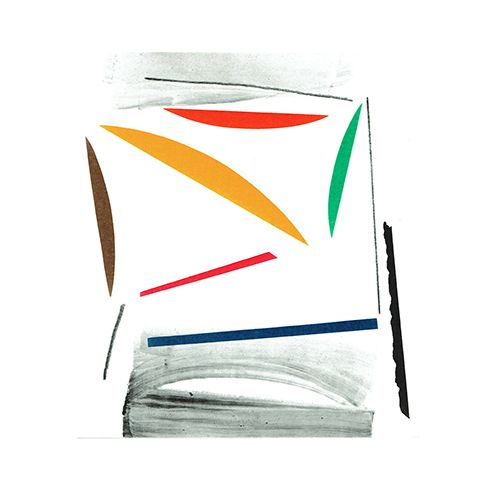
Willard Boepple is a sculptor who is based in New York and Vermont.
Kip Gresham is the founder and director of The Print Studio, Cambridge.
Katherine Oliver is the founder and director of Oliver Projects.
|
|


